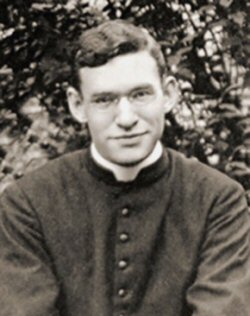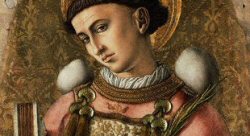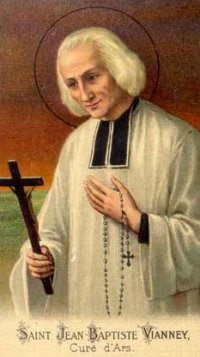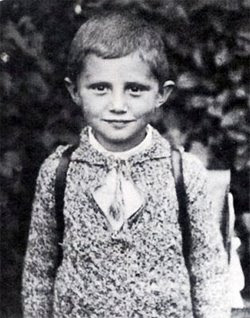My Conversation with Cincinnati’s Vocations Director
Rich LeonardiFebruary 23, 2007
Cardinal Francis Arinze, prefect of the Congregation for Divine Worship and the Sacraments, spoke at a 26 October 2006 colloquium to celebrate the golden jubilee of the Institut Supérieur de Liturgie of the Institut Catholique de Paris. He addressed a range of topics that impact the liturgy, and his comments about vocations and the priesthood are especially worth highlighting:
If a diocese does not have enough priests, initiatives should be taken to seek them from elsewhere now, to encourage local vocations and to keep fresh in the people a genuine "hunger" for a priest (cf. John Paul II, "Ecclesia de Eucharistia," No. 32). Non-ordained members of the faithful who are assigned some roles in the absence of a priest have to make a special effort to keep up this "hunger." And they should resist the temptation of trying to get the people accustomed to them as substitutes for priests (cf. op. cit., No. 33). There is no place in the Catholic Church for the creation of a sort of parallel "lay clergy" (cf. "Redemptionis Sacramentum," Nos. 149-153,165).
Priests on their part should show themselves transparently happy in their vocation with a clear identity of their liturgical role. If they celebrate the sacred mysteries with faith and devotion and according to the approved books, they will unconsciously be preaching priestly vocations. On the other hand, young people will not desire to join a band of clerics who seem uncertain of their mission, who criticize and disobey their Church and who celebrate their own "liturgies" according to their personal choices and theories.
One of the best kept secrets in the story of American vocations is the turnaround that has taken place in Cincinnati. From barely a trickle of priestly ordinations in the early nineties, Cincinnati now boasts 4-8 new priests per year. Much of the credit goes to former vocations director Fr. Mark Watkins, an orthodox priest who took to heart the idea that "a man will give his life for a mystery, but not a question mark."
Cincinnati's vocations program is now in the able hands of his successor, Fr. Kyle Schnippel, an energetic young priest with ambitious goals. Fr. Schnippel entered seminary at the age of 19 for the Archdiocese of Cincinnati. He first attended the Pontifical College Josephinum in Columbus, Ohio, before completing his theological training at Cincinnati's Mt. St. Mary's Seminary of the West. After his ordination in May 2004, he taught full time for two years at Elder High School before becoming vocations director in July 2006.
I recently interviewed Fr. Schnippel about the state of vocations in Cincinnati and across the U.S. and sought his reaction to Cardinal Arinze's address. [Editor's note: Look for a four-part series "Why Does the Catholic Church Ordain Only Men to the Priesthood?" by Fr. Kyle Schnippel, to run on Monday and Thursday for two weeks in this space, beginning on February 26th.]
Rich Leonardi: How many men are studying for the priesthood in Cincinnati's seminary, Mount St. Mary's of the West?
Fr. Schnippel: There are currently 37 men studying for the priesthood at Mount St. Mary's. Of these, 28 are for the Archdiocese of Cincinnati, with the other nine from Toledo, Youngstown, Kalamazoo, and Covington, KY. The Archdiocese also has five men studying at the College of Liberal Arts at the Josephinum and one candidate at the North American College in Rome.
Rich Leonardi: What are your goals for the Archdiocese of Cincinnati?
Fr. Schnippel: A goal outlined three years ago was to work towards 10-15 ordinations per year, up from our current average of 5. To put that in terms of numbers of seminarians, that would be 70 plus, which would include 20-30 new seminarians each year. This number would help us to turn around the current decline in the number of priests for the Archdiocese.
Rich Leonardi: Do young men sometimes have mistaken notions about the "sound" of the call to the priesthood? How did you discern your call?
Fr. Schnippel: Most often when a young person is hearing the call to priesthood or religious life, they want an absolutely clear sign that this is what they are supposed to do. Unfortunately, God normally does not work in such a way, hence our poster campaign and slogan is: "There are rarely trumpets or midnight visions." When I am working with a young man who wants this clarity, I start to ask about movements in the heart, what gives him joy and contentment, and start to use this avenue as a way of showing him that this is where God's call starts to be heard, in the ear of the heart. I also try to meet with a prospective candidate for the first time at the seminary, because if he feels comfortable in the building, he is much more likely to respond to the call that God is giving. For me, I was a freshman at Ohio State University when I unmistakably heard the call. I was Pre-Medicine at the time, but heard a talk on vocations to the priesthood and religious life. I could not get the idea out of my mind, so I arranged a visit to the Josephinum, which is in Columbus as well. When I walked on campus, I felt right at home and made up my mind to enter the next fall, which is what happened.
Rich Leonardi: Is there an observable connection between large families and priestly vocations?
Fr. Schnippel: As one of six children, I think it certainly helps because you learn to share and to have a concern for one another from a very early age. For me, it helps to also live life as a celibate man because I have a close relationship with my nieces and nephews (soon to be 15!) Large families also help with the parents supporting their children to the priesthood or religious life, as they see ample opportunity for grandchildren. I should say, however, that one of my closest friends in the priesthood is an only child, so God works how He will.
Rich Leonardi: Do you sense that the vocations "boomlet" experienced by Cincinnati and other dioceses will continue?
Fr. Schnippel: I certainly hope so! I get the sense, and this is also from teaching in a high school, that young people want to live for something more. They are starting to realize the superficiality of the world, and want their lives to have meaning. They see relatives that have lots of money, but are not happy, and they do not want to be in that situation. Also, teenagers are oriented to the Truth. When they hear the Truth proclaimed in all of its beauty, they are attracted by that. I think as catechesis continues to improve, this ‘boomlet' will continue to grow.
Rich Leonardi: What are you doing to help create what Cardinal Arinze calls a "hunger" for priests and what can the laity do to help?
Fr. Schnippel: I am trying to do a couple of things. By my preaching on Sundays in different parishes, I am trying to get the word out there is a need for priests, and that the life can be fulfilling. By starting a blog (
Called by Name), I am trying to answer questions about what does it take to be a good priest (prayer and faithfulness). I want young people to realize that by giving their life for something more, something deeper, they actually gain much more than they could in any other way.
The laity can help this in many different ways, first and foremost by their prayers. This is one of the few things that Jesus specifically tells us to pray for. Also, your priests need support. It is tough to be in a parish where there are so many demands on a pastor, and he often feels pulled in so many different directions. When you hear criticisms of the priest, do you challenge or correct false interpretations? Is your pastor a friend? Would you feel comfortable asking him to dinner? So, what can the laity do? Pray for vocations, and support and encourage their priests.
Rich Leonardi: Cardinal Arinze warns against creating a "parallel lay clergy." Do you worry that the rise of pastoral administration programs in dioceses across the country are moving us in that direction?
Fr. Schnippel: Absolutely! Do not get me wrong, I am in support of parishioners taking ownership of their parish and their faith, and in being involved in the running and guiding of a parish, but there were many in the early days of lay ministry who saw it as a first step towards the ordination of women and/or married men. When a lay ecclesial minister starts to take over some of the important functions of the parish, without giving due respect to the priest and his role of pasturing, it sends a message to young people: "Why should I give up a wife and family, if I can do just about everything that Father does as a lay minister?" I think it can send confusion over who is in charge, the priest or the lay administrator. It also confuses the role of the priest to be a mere functionary: he provides the Sacraments, we do everything else. The priest is more than a functionary.
Rich Leonardi: Cardinal Arinze suggests that priests can "unconsciously" preach on behalf of vocations by conducting themselves with liturgical fidelity. How does this square with your experience?
Fr. Schnippel: It is pretty simple, actually: happy priests attract other priests. A priest who is content and fulfilled in his ministry, who loves his people and his parish (even with the warts) will have that joy come across in what he does and how he interacts with his parishioners. Then, when a young man thinks about the priesthood, the image of a happy man who is making a difference in other people's lives will come up. Faithfulness attracts others, because people recognize that it is not about him, it is about him leading others to Christ, whom he knows and loves. It very much squares with my experience. Parishes with good, strong pastors, who have a clear identity of who they are, attract more vocations than a parish that is run by a team without strong leadership from the priest.
© Copyright 2007 Catholic Exchange
 Bishop Michael Burbidge was interviewed on WRAL TV's "Headline Saturday", and speaks about many issues related to the faith - especially vocations and the priesthood. While the "purpose" of the show was to discuss his first six months as Bishop of the Diocese of Raleigh, he also deftly handles some rather pointed questions about "hot button" issues, doing great apologetics work and proclaiming the Truth all the while. We are truly blessed to have this great Shepherd leading our Diocese! DEO GRATIAS
Bishop Michael Burbidge was interviewed on WRAL TV's "Headline Saturday", and speaks about many issues related to the faith - especially vocations and the priesthood. While the "purpose" of the show was to discuss his first six months as Bishop of the Diocese of Raleigh, he also deftly handles some rather pointed questions about "hot button" issues, doing great apologetics work and proclaiming the Truth all the while. We are truly blessed to have this great Shepherd leading our Diocese! DEO GRATIAS



























